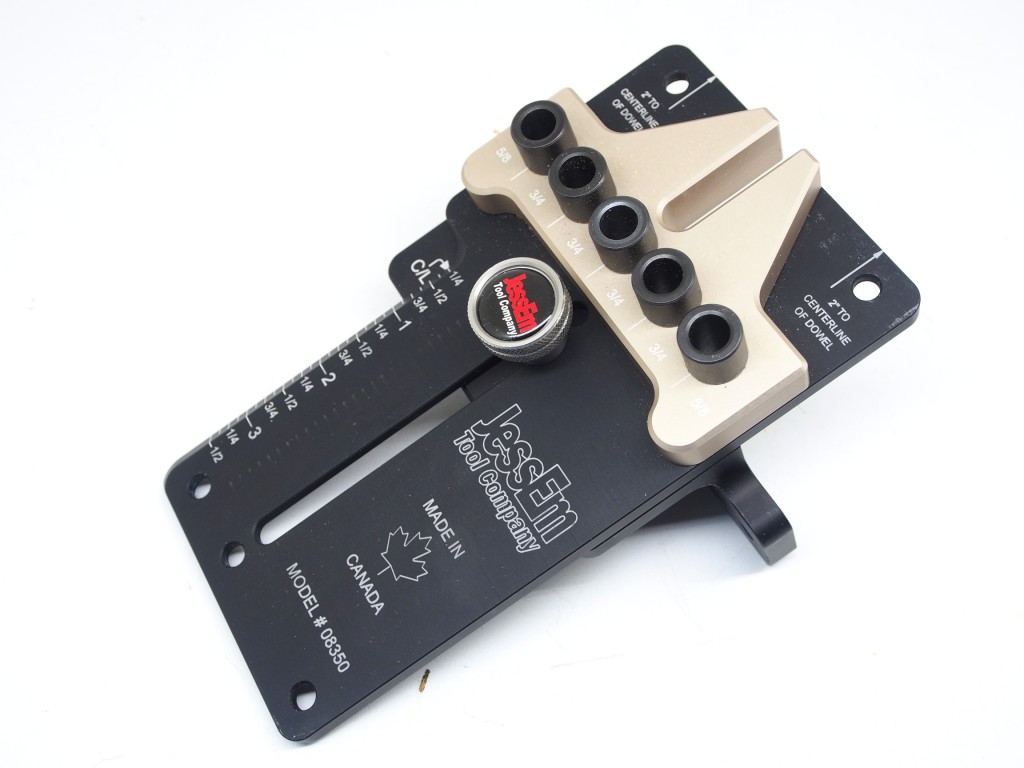Dowels may be becoming in more vogue again, but what about their strength? The problem with deciding whether one fastener is better than another is that fact that it is a fairly broad thing to test. It has to do with many differing factors: the diameter, length, and species of the dowel, the type of adhesive used, and or course the characteristics of wood being joined.
Most of the explorations into dowel strength have compared them to other joints using simple tests of joint failure. A good example is this experiment from Canadian Woodworking from 2010. They tested a T joint in solid oak by comparing: (i) a 3-dowel joint (⅜”×2″), (ii) a mortise and tenon joint, and (ii) a 2-biscuit joint. The biscuit failed at 325lbs of force, the M&T at 500lb, and the dowel-joint at 650lbs. An article, “Joint Success” in British magazine Furniture & Cabinetmaking showed the following failures (tested using a hand-pump hydraulic ram) is shown in the table below. None of the fixings failed.
| Method | Specs | failure (psi) | What failed? |
|---|---|---|---|
| biscuit joint | 1 × No.20 | 180 | glue line + fracture of material parallel to biscuit slot |
| Dowelmax | 5 × 10×50mm dowels | 660 | glue line |
| Domino | 2 × 8×40mm tenons | 400 | glue line + partial fracturing along the grain |
| mortise and tenon | 45mm depth | 420 | glue line |
| pocket hole | 280 | screw and glue line |
Yet another test from the November 2006 issue of Wood Magazine “Wood Joint Torture test”.
| Method | Shear test (lbs) | Pull-apart test (lbs) |
|---|---|---|
| mortise and tenon | 1017 | 2525 |
| Dowelmax | 609 | 1866 |
| Beadlock | 541 | 1486 |
| Domino | 464 | 1170 |
| biscuits | 187 | 766 |
The reality is that actual testing of joints would likely have to include the use of different species of wood for dowels, the use of various glues, and the application to various types of connections, and target species. It would require a large study that also assessed the effect adhesive curing has on the strength of a joint. There is actually a load of commercial research into the area of fastener strength, which isn’t really that surprising. This is partially because it is the most commonly used joint in commercial furniture construction (largely due to the fact that it is inexpensive). With the resurgence of interest in multi-storey wooden buildings, there will no doubt be more interest in the use of dowels in timber engineering. Below are some examples of dowel strength in the literature.
In a 2022 article from the Warsaw University of Life Sciences [1], the authors investigated the influence of the type of invisible wooden connectors on the strength in glued corner joints for chipboard and MDF, which are commonly used in the construction of box furniture. They used (i) four wood grooved beech dowels, (ii) two beech Domino tenons, and (iii) a mixed arrangement of connectors. Results showed that dowels provided the highest strength over Domino tenons. They also determined that the use of MDF over chipboard increased the strength.
Many studies look at withdrawal strength, which isn’t exactly the sort of strength tests you see in peoples workshops. A 2020 study [2] looks at the withdrawal strength of 8mm plain and spiral dowels made of beech and oak. The authors investigated the influence of relative humidity, dowel structure and wood species on withdrawal strength. Spiral dowels were found to have a significantly higher withdrawal strength over plain dowels. The influence of the wood species was not found to be statistically significant overall.
Another study [4] looked at the joints made from hardwood plywood of 19 mm thickness, using beech and hornbeam multi-grove dowels in various diameters (6, 8 and 10 mm) and depths of penetration (9, 13 and 17 mm). The best results were for joints made with 8mm beech dowels penetrating 17mm into the joints. The 10mm diameter dowels failed, likely due to reduced edge thickness in the panels. In general strength does increase with dowel diameter. There are even studies which look at optimal dowel spacing. In one study [5] the author found that the optimal spacing of dowels in cabinet construction (MDF and particleboard) was 96mm. Spacings of 32mm and 64mm resulted in a reduction of the maximum load-bearing capacity per dowel due to over-lapping zones of influence by neighbouring dowels.
There are even studies that look at structural joints made with axially loaded glued-in hardwood dowels [3]. The authors of one study [3] look at various large plywood (Glulam) beam configurations held together with a series of 12mm by 120mm dowels. Withdrawal strength was found to be about 30 MPa (4351 psi), and overall joints have high strength properties (except the dowel joints do succumb to brittle shear failure of adhesives or wood members).
In all likelihood, dowels are a very good choice for holding together a joint in a piece of furniture. I mean in normal furniture there is never really going to be the excess loading applied in testing. You just have to make the appropriate choice for the material being used. For most circumstances, that’s likely a ⅜” diameter spiral dowel, made of a species like beech. It may be even possible to use them to join larger structures such as workbench bases, where multiple ½” diameter dowels, 3-4 inches in length could be used.
Further reading
- ŚMIETAŃSKA, K., MIELCZAREK, M., “Strength properties of furniture corner joints constructed with different wooden connectors and wood-based materials”, Ann. WULS – SGGW, Forestry and Wood Technology, 118, pp.55-66 (2022)
- Podlena, M., Böhm, M., Hýsek, S., Procházka, J., Černý, R., “Evaluation of Parameters Influencing the Withdrawal Strength of Oak and Beech Dowels”, BioResources, 15(1), pp.1665-1677 (2020)
- Koizumi, A., Jensen, J.L., Sasaki, T., “Structural joints with glued-in hardwood dowels”, Joints in Timber Structures, pp.403-412 (2001)
- Dalvand, M., Ebrahimi, G., Tajvidi, M., Layeghi, M., “Bending moment resistance of dowel corner joints in case-type furniture under diagonal compression load”, Journal of Forestry Research, 25, pp.981-984 (2014)
- Tankut, A.N., “Optimum dowel spacing for corner joints in 32-mm cabinet construction”, Forest Products Journal, 55(12), pp.100-104 (2005)



